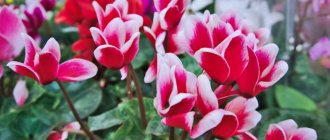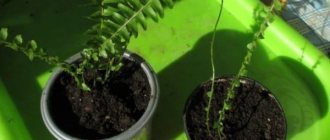The plant Clerodendrum, also called clerodendron, belongs to the Verbenaceae family of the order Lamiaceae. This genus is represented by evergreen and also deciduous shrubs and trees. Under natural conditions, such a plant is most often found in tropical Africa, South America and Asia. In total, this genus includes approximately 400 species. The name of this culture translated means “tree of fate”; it is also called “innocent love” or “volkameria”. The cultivation of this plant began several hundred years ago. However, clerodendrum began to be grown as an indoor flower relatively recently, but during this time it has already become very popular among both designers and flower growers.
Brief description of cultivation
- Bloom . It starts in June and ends in the first weeks of autumn. Flowering of fragrant clerodendrum is observed almost all year round.
- Illumination . Bright but diffused light is needed (windows of western or eastern orientation, while the bush on the southern windowsill must be shaded).
- Temperature regime . During the growing season and flowering, the temperature should be from 18 to 25 degrees, and during the dormant period - from 13 to 15 degrees.
- Watering . It should be plentiful. The soil mixture is moistened after its surface has dried.
- Air humidity . She must be tall. To do this, in spring and summer, moisten the bush every evening with a spray bottle, and in winter, remove it away from heating appliances.
- Fertilizer . Feeding is carried out from the second half of spring until the last days of summer regularly once every 15 days. To do this, use a mineral complex fertilizer for flowering plants.
- Rest period . When flowering ends in the autumn-winter period.
- Trimming . At the very beginning of active growth.
- Transplant . The plant is replanted at the beginning of the growing season. While the bush is young, it should be replanted regularly once a year, and an adult plant - once every 2 or 3 years.
- Reproduction . By cuttings and seed method.
- Harmful insects . Whiteflies, aphids and spider mites.
- Diseases . Rot and chlorosis.
For complete comfort
Suitable soil will be soil that is as similar in composition to the natural one for this foreign guest. Knowing the required proportions, you can prepare it yourself or purchase a ready-made mixture at a flower shop.
In both cases, it is important to disinfect before planting; it will prevent various diseases of the seedlings.
Features of clerodendrum
The clerodendrum plant has the following features:
- The rich green leaf plates of clerodendrum are whorled or oppositely arranged, simple, heart-shaped with a rough “quilted” surface. Their length varies from 20 to 30 centimeters, and the edge can be solid or jagged. In the lower part, the flexible stems quickly become woody. The terminal racemes or corymbose inflorescences consist of very showy flowers with long stamens.
- In most species, the flowers have a butterfly shape, but in Clerodendrum benguet and Clerodendrum philippines the inflorescences look like unusually shaped bouquets.
- The foliage and flowers of most species emit a scent. Moreover, all types have a different aroma.
- The most popular among flower growers are 2 species, namely: brilliant clerodendrum and Thompson's clerodendrum. But other species are also grown at home.
- With the help of pinching and pruning, the bush can be given different shapes, or rather, bush-like, hanging or standard.
- It is not difficult to care for such a flower, as it is unpretentious and hardy, and it is also very effective and has a wonderful aroma.
Clerodendrum - secrets of care and cultivation at home. Why doesn't it bloom and the leaves turn yellow?
What you can't do without
One of the needs is full lighting, but direct exposure to rays is undesirable. Experts advise placing it near windows facing west or east. If there is not enough light, the long-awaited flowering may not occur.
Caring for clerodendrum at home
Since clerodendrum is a tropical plant, in order for it to grow and develop within normal limits, conditions must be as close to natural as possible.
Illumination
The flower needs a lot of light, but it must be shaded from the direct rays of the sun. Windows with western, eastern or southern orientation are best suited for it.
Temperature
During the growing season, the optimal air temperature is from 18 to 25 degrees. And in winter, during the dormant period, the bush should be in a cool place (no more than 15 degrees).
Air humidity
The plant needs high air humidity; therefore, every evening in spring and summer it needs to be moistened with a sprayer, for this purpose well-settled water is used. In winter, clerodendrum is placed as far as possible from operating heating appliances.
Watering
Water the flower abundantly and use soft water for this. However, the top layer of the substrate in the pot must dry out between waterings. During the dormant period, the amount of watering depends on the air temperature in the room, namely, the colder it is, the less frequently the substrate needs to be moistened. However, under no circumstances should you allow the earthen clod to dry out completely.
Fertilizer
Feeding is carried out once every 15 days from the second half of spring until the end of the summer period. To do this, use complex mineral fertilizer for flowering indoor plants. In autumn and winter, there is no need to feed clerodendrum.
Bloom
Depending on the species, the plant begins to bloom in June. And the flowering of clerodendrum ends around September. It looks very impressive when white bracts form on the bare stems of Thompson's clerodendrum at the very beginning of spring, and then beautiful crimson flowers appear from them, reaching about 25 mm in diameter. Flowering of the fragrant clerodendrum lasts throughout almost the entire year, and the beautiful clerodendrum lasts from June to September, while paniculate inflorescences appear, consisting of flowers of a purple hue. Clerodendrum blooms so spectacularly that you will certainly want to see its flowers again.
Trimming
This plant must be regularly pruned every year at the very beginning of the growing season. The first step is to remove all weak and dried shoots, after which all stems are shortened by 1/3. If pruning is carried out in a timely manner, the young side stems will grow and branch more actively, and it is on them that inflorescences are formed. As a result, proper pruning promotes more luxuriant flowering.
Pruning is also necessary to shape the crown. So, in order for this flower to grow as a bush, it is necessary to shorten the stems very much during pruning in the spring, otherwise it will be necessary to install a support for them later. With proper pruning, the bush can be given the shape of a tree. In order to create a standard form, cut off all the shoots, leaving only 1 strongest one; it is shortened at a height of 0.5–0.7 m. The stems growing in the area of the top need to be pinched, thanks to this it will be possible to form a beautiful crown. Sprouts growing on the stem below the crown must be trimmed in a timely manner.
Clerodendrum transplant
Periodically replace the old substrate in the pot with clerodendrum with a new one; for this purpose, replanting is carried out. This procedure is also carried out if the root system becomes very crowded in the pot. Transplantation is carried out at the very beginning of the growing season after the bush is pruned. While the flower is young, it should be replanted regularly once a year, and older bushes undergo a similar procedure once every 2 or 3 years.
The substrate for clerodendrum is fertile and slightly acidic (pH 5–6). For planting, you can take a store-bought soil mixture into which you should add a little sand. You can also prepare an earthen mixture with your own hands; to do this, combine coarse sand, peat, clay and leaf soil, taking them in equal parts. Before replanting, it is necessary to disinfect the fresh soil mixture using steam, an oven or a microwave.
The new pot should be a couple of centimeters higher and larger in diameter compared to the old one. At its bottom, first make a good drainage layer about 30 mm high, then, by transshipment, transplant the flower into a new pot, while trying to keep the earthen lump intact. All voids in the pot must be filled with fresh soil mixture, after which the bush must be watered. If the flower eventually needs support, then it should be installed immediately during replanting, since then if you start sticking a stick into the substrate, it can injure the roots.
Clerodendrum Thompson. Transplant No. 2, pruning and new shoots!
For aesthetic pleasure
The most interesting section of courting a tropical beauty is its design. It can be given the desired shape.
To do this you will need appropriate pruning:
- small tree - excess branches are removed, leaving one strong shoot. All young shoots are plucked off from it, and it is shortened if it becomes more than half a meter in height;
- voluminous bush - to give this shape the tops are pinched;
- cascading vine - it is enough to shorten the branches a little at the ends in early spring, and also remove the stems with new buds in time.
Reproduction methods
Indoor clerodendrum can be propagated by seeds and cuttings.
Growing from seeds
Sowing of seeds is carried out in the last days of February or the first days of March. To do this, fill the container with a soil mixture consisting of sand, turf soil and peat, and evenly distribute the seeds over its surface. After this, the crops are placed in a mini-greenhouse and provided with good lighting. Ventilate them regularly and promptly moisten the surface of the soil mixture. With proper care, the first seedlings should appear after 6–8 weeks. After the seedlings have formed 4 true leaf plates, they should be cut into individual small cups, reaching about 60 mm in diameter. Also, 3 seedlings can be planted in pots up to 11 centimeters in diameter. After the plants take root and begin to grow, they begin to gradually accustom them to conditions suitable for adult bushes.
Propagation by cuttings
If you already have clerodendrum, you can propagate it by cuttings. After the bush is pruned in the spring, you will be left with cuttings of shoots that can be used as cuttings. Roots on cuttings appear quite easily in spring and summer, and rooting is carried out in water. When the cuttings take root, they are transplanted into separate pots, approximately 70 mm in diameter, after which they are covered with a glass cap. Make sure that the surface of the soil mixture is moist at all times. After the root system of the cutting is fully formed and new stems and foliage grow, it, along with a lump of earth, is carefully transferred into a new larger container (diameter about 90 mm). The clerodendrum will grow in this pot until spring (there is no need to cover it with a cap). After 1 year has passed since the beginning of rooting, the bush must be transplanted by transferring it into a larger container, reaching 11 centimeters in diameter, and the soil mixture must be used that is suitable for an adult plant. During this year, the stems on the bush need to be pinched at least 2 times, thanks to this the flower will be more magnificent.











